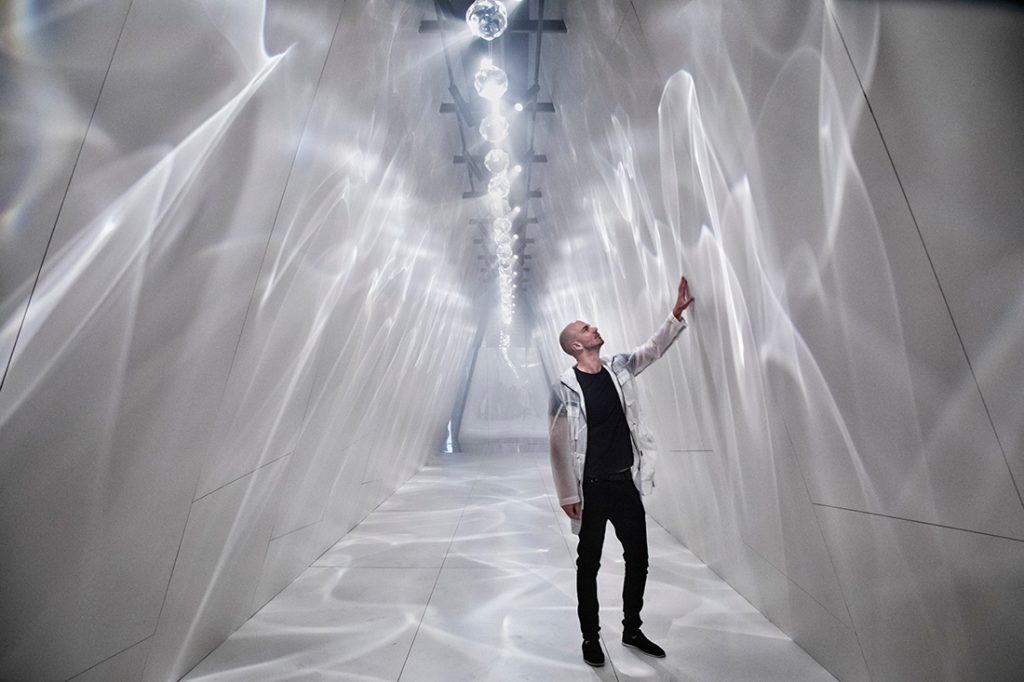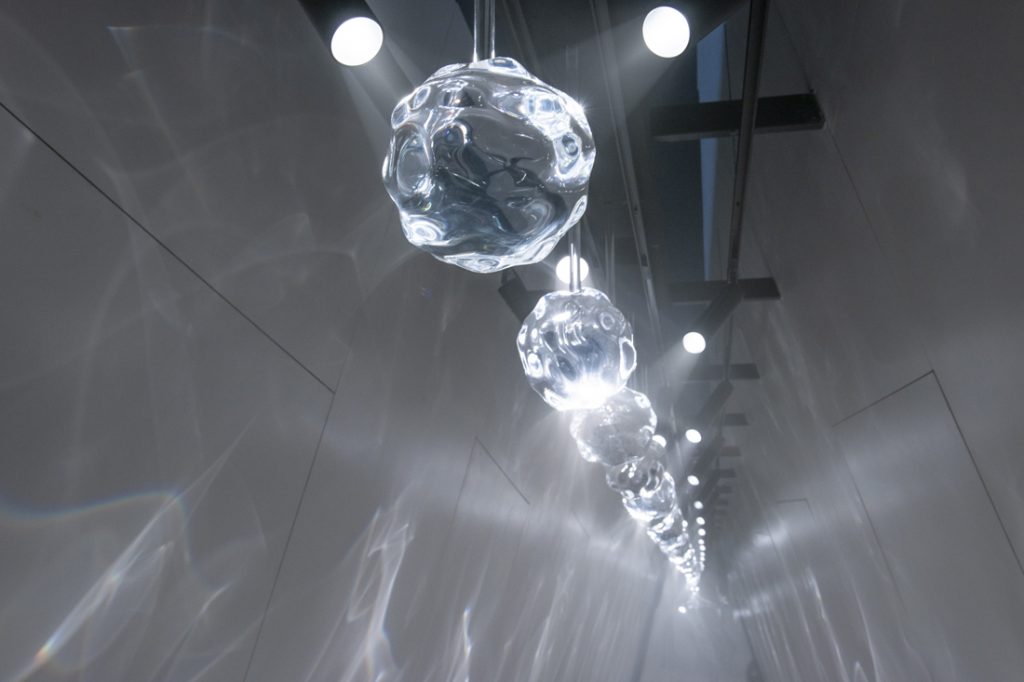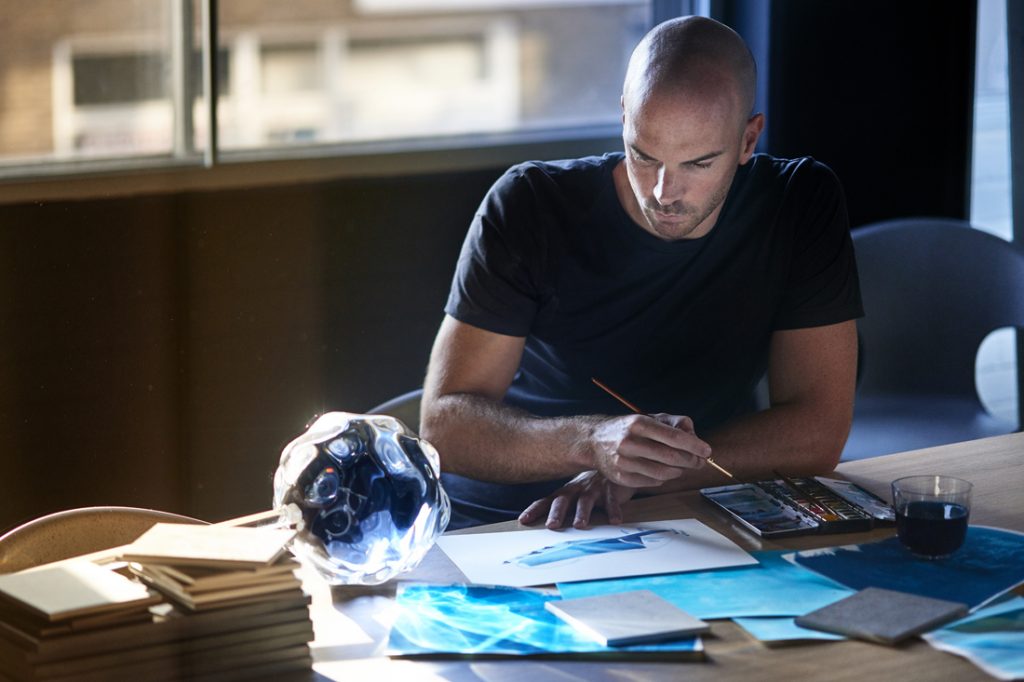Immersion in a surface material is possible! Benjamin Hubert of LAYER shows us how with Dekton and light in a poetic installation for Cosentino in Milan.
Following a successful preview during the recent Madrid Design Festival 19, Raytrace – designed by Benjamin Hubert of LAYER for Cosentino – now exhibits at Milan Design Week 2019. The immersive architectural installation showcases the material qualities of Cosentino’s Dekton surface and how it can come to life with light.
Exhibited in the historic vaulted warehouses beneath the Central Train Station, Raytrace is a 25-metre-long, six-metre-high triangular passage composed of 380 square metres of the ultra-compact surface Dekton Slim, with a thickness, or rather thinness, of only four millimetres. Seemingly balanced on a single edge within the dark atmospheric tunnels of Ventura Centrale, the surfaces create a large passageway that visitors can walk through.

Photo by David Zanardi.
Upon entering the passageway, a mesmerising caustic pattern – made possible by 29 glass spheres and 87 LED lights – slowly dances across the surface, emulating light refraction through water. The effect gives visitors the sense of being underwater without the need for scuba-diving equipment nor the ability to swim. They also become part of the installation when their shadows are cast against the structure’s surface. Two mirrors at either end of the vault reflect the installation, further creating the illusion of an infinite space.

Photo by David Zanardi.
Drawing inspiration from Dekton’s creation process when designing Raytrace, Hubert ultimately put the element of water back onto the material with a caustic optic effect. “The extraction of water using extreme heat and pressure throughout the manufacturing process is what makes Dekton a durable material most suited for architecture. Raytrace is a direct response to this method,” says Hubert. “But the most important thing about Raytrace is how it makes people feel. We encourage people to touch it, to interact and really experience the properties of Dekton.”

Photo by Jose Santopalomo.
A powerful combination of design, nature and emotion, “the installation not only demonstrates the versatility of Dekton, but we hope that it can inspire architects and designers to think about the future of architecture and use our material in new ways,” says Santiago Alfonso, Vice President of Marketing and Communication at Cosentino Group.
Catch up on all the latest news from Salone del Mobile here. And join our mailing list to keep in the design loop.
A searchable and comprehensive guide for specifying leading products and their suppliers
Keep up to date with the latest and greatest from our industry BFF's!

BLANCOCULINA-S II Sensor promotes water efficiency and reduces waste, representing a leap forward in faucet technology.

Elevate any space with statement lighting to illuminate and inspire.

Within the intimate confines of compact living, where space is at a premium, efficiency is critical and dining out often trumps home cooking, Gaggenau’s 400 Series Culinary Drawer proves that limited space can, in fact, unlock unlimited culinary possibilities.

In this candid interview, the culinary mastermind behind Singapore’s Nouri and Appetite talks about food as an act of human connection that transcends borders and accolades, the crucial role of technology in preserving its unifying power, and finding a kindred spirit in Gaggenau’s reverence for tradition and relentless pursuit of innovation.

Register now for your free ticket

From a modular armchair and statement lighting, to a table crafted from coffee waste and reissued classics, these are the best new products to launch at this year’s Milan Design Week.

With its inspiring in-showroom installations, The Project is one of Saturday Indesign’s major highlights. The 2023 People’s Choice winner is ‘f l u i d’ by Plus Architecture with AXOR.

Tilt and First Peoples artist Lisa Waup have collaborated to bring an Indigenous public art installation to Melbourne’s Westgate Freeway. This artwork integrates Indigenous narratives into the urban landscape in a significant Australian first.
The internet never sleeps! Here's the stuff you might have missed

Sydney’s first surf park by ClarkeHopkinsClarke and OCULUS is a truly mixed-use project combining sporting, leisure, training, hospitality, retail and community facilities.

Events continue apace at Tadao Ando’s MPavilion in Melbourne’s Queen Victoria Gardens, as Season 11 progresses into 2025.